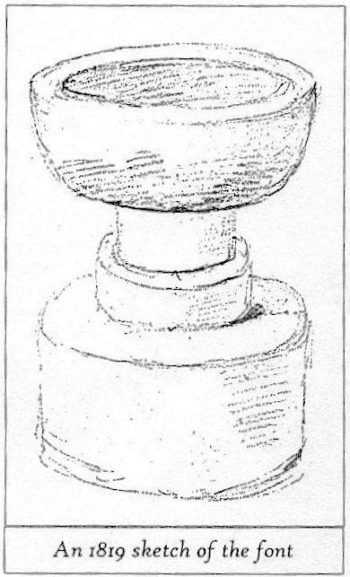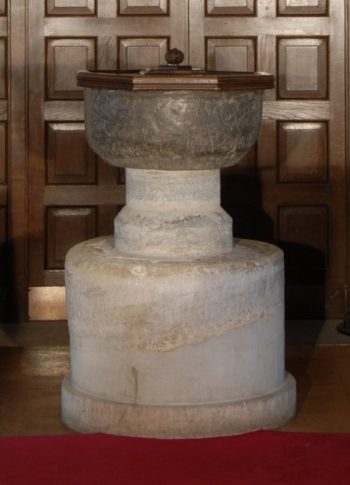The medieval rite of baptism was a very serious and important ceremony, full of rich meaning and symbolism. Without baptism, there was no hope of heaven and together with the Eucharist it was regarded as one of the two most significant of the seven Sacraments considered necessary for salvation.[1]
The baptismal service was very much longer and more elaborate than it is in the Anglican Church today.[2] It was in two parts and began in the porch, or outside the door if there was no porch. The priest made the sign of the Cross three times, recited appropriate prayers and commanded the Devil to depart from the child, often opening the north door, known as the Devil’s door, to allow him to escape. Jesus’ welcome to children (Mathew 19, 13-15), ‘Suffer little children and forbid them not to come unto me; for of such is the Kingdom of Heaven’, was read and the godparents joined the priest in repeating the Lord’s Prayer, Hail Mary and Creed, in Latin.
The child was then taken into the church, to the font, which was invariably placed in a prominent position just inside the principal entrance (usually on the west side of it), to remind people that baptism is the door by which a child was brought into the Church.[3] For Penn, the main door in the early Middle Ages was on the south side, directly opposite where it is now. There was no south aisle and so the font would have been in the nave near the south door. The door led out into a large porch, of which you can still see the line of the gabled roof above the central arch of the nave.
In the mid-14th C, a south aisle was added on each side of the high porch. It had a low sloping roof attached to the outside of the nave. The porch retained its high gabled roof but would have lost its side walls to allow a continuous new aisle and was presumably extended, if not already long enough, to form a new porch outside the new aisle. The font is likely to have been moved at that time from the nave into the south aisle, just to the west of the new door from the porch. There is a photograph of it in that position in 1899. The font was still there in the 1950s, when it was moved to its present position in front of the west door, partly because it was then believed, although there is no evidence for it, that this was once the main door to the church.[4]
The setting of the font was sometimes enhanced by mounting it on decorated steps, by having an extremely elaborate cover, or even by a ciborium, a canopy of beautifully carved wood or stone. Penn had none of these additions, but even so, until wooden pews became customary in the 15th C, there would have been an uninterrupted view of the font across the church.
After lengthy prayers at the font, the priest poured holy oil into the water. The godparents renounced Satan and made their profession of faith and the child was anointed with the ‘oil of salvation’ and then baptised, naked, with three immersions in the name of the Trinity, the Father, Son and Holy Ghost. It’s forehead was then anointed with sacred chrism (holy oil) and a white chrisom cloth was bound round it as a symbol of the cleansing of its sins, and was kept in place for the following week. Finally, the child was dressed in a white chrisom robe, which, if the child died within a month, was used as a shroud. The child was given a blessed, lighted candle, which therefore had the power when lit, to banish the Devil.
At various stages the priest carried out what the Protestants described as ‘dark and dumb ceremonies. He blew air into the child’s mouth as a symbol of the out-pouring of the Holy Spirit, blessed and placed salt on the tongue with the words, ‘Receive the salt of wisdom’. He put his saliva on the child’s ears and lips and made the sign of the cross on head, breast and hands.[5]
The godparents were charged to teach the child the Lord’s Prayer, Hail Mary and Apostles’ Creed, to return the chrisom and to bring the child to confirmation as soon as the bishop came within seven miles of the church. They were thereafter regarded as related both to the child and to eachother. If two godparents of the same child wished to marry, they needed a dispensation to do so.
Holy water was treated with enormous care and reverence. Not only was the font covered with a lid, but between the lid and the rim there was a font cloth made of linen or silk in order to protect the holy water from dust. Until 1236, the water was left in the font and changed only twice a year, at Easter and Pentecost. Thereafter it had to be changed each week and it was not until after the Reformation that the water was changed for each baptism.
The used holy water was drained through a small pipe in the bottom of the font directly into the earth in order to be unsullied by human hands. There is a ¾ inch diameter drain pipe in the bottom of our font for this purpose. Godparents who handled the newly baptised child were required to wash their hands before leaving lest any of the chrism adhered to them and the water used for washing was then tipped into the font and down the drain. After a private baptism in a home, both the holy water and the vessel that contained it had to be either burnt on the fire or carried back to the church for disposal there.
There was an absolute belief in the objective power of sacred things, gestures and formulae, particularly the sign of the cross, to banish the Devil. One of the parish clerk’s ‘perks’ was the payment he received from every household for taking round a supply of holy water. It was sprinkled on the hearth to fend off evil, and in byres and on fields and even on the marriage bed to encourage fertility. Sick animals were given blessed salt to eat and holy water to drink. Blessed candles were lit during thunderstorms to drive away demons from the agitated air, and placed near women in labour and in the hands of those dying, to keep the Devil at bay.[6]
The Protestants were brutally dismissive of what they saw as this superstitious idolatry. Thomas Cranmer, Archbishop of Canterbury from 1532 to 1556, was the author of the first two versions of the English Prayer Book. He was the principal architect of the Reformation until burned as a Protestant martyr by Queen Mary when he famously thrust the hand that had recanted his Protestant belief first into the fire. It is very largely his baptismal service of 1552 that passed into the 1662 Book of Common Prayer, which we still use today, and it was his chaplain who pointed out that in biblical accounts of baptism, there was,
‘neither hallowed font, nor holy water, salt, oil, cream, spittle, candle, or any other part of papistry’. Elsewhere, he wrote, ‘For Baal’s priest, before the child can be baptised, bewitcheth the water, shutteth the church door, conjureth the devil out of the poor young infant, bespueth the child with his vile spittle and stinking slavering, putteth salt in the child’s mouth, smeareth it with greasy and unsavoury oil, &c.’
Typical Puritan views were ‘hawlowed oyle is not better than the Busshop of Rome’s grese or butter’, and ‘holy water, if ther be put an onyon therunto, it is a good sawce for motton’[7]
[1] These were baptism, confirmation, the eucharist, penance, extreme unction, matrimony and holy orders.
[2] I am particularly grateful to W.Norman Paul who has been the source of many fruitful ideas, through correspondence; his book Enjoying old parish churches, I (1996); and his article ‘English fonts and font covers: developments in styles and designs’, The Local Historian 23, No 3 (Aug 1993). J.G.Davies, The architectural setting of baptism (1962) provided much useful background. Elliott Viney, until recently the President of the Bucks. Arch. Soc., who knows Penn church well, has kindly commented helpfully on the typescript.
[3] J.G.Davies, op. cit., pp. 61-3
[4] Conversation with the Rev. Oscar Muspratt, Vicar of Penn 1944-89
[5] J.G.Davies, op. cit., p.92
[6] Eamon Duffy, The stripping of the altars (1992), pp.280-1
[7] J.G.Davies, op.cit., p.94
© Miles Green, January 2004.
 The earliest surviving sketch of the font was made in pencil, in 1819, and is in the British Museum. It was noted that it was made of lead. There was no font cover shown. The present octagonal, oak lid is Victorian, its shape laid down by the leaders of the Gothic Revival as representing the seven Sacraments and crucifixion.
The earliest surviving sketch of the font was made in pencil, in 1819, and is in the British Museum. It was noted that it was made of lead. There was no font cover shown. The present octagonal, oak lid is Victorian, its shape laid down by the leaders of the Gothic Revival as representing the seven Sacraments and crucifixion.

